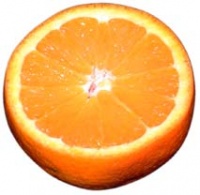Orange: Difference between revisions
From Cunnan
Jump to navigationJump to search
No edit summary |
mNo edit summary |
||
| (6 intermediate revisions by 5 users not shown) | |||
| Line 1: | Line 1: | ||
| ⚫ | |||
A Southeast [[Asian]] evergreen tree of the genus Citrus, widely cultivated in warm regions and having [[fragrant]] white flowers and round fruit with a yellowish or reddish rind and a sectioned, pulpy interior. |
|||
==Orange ([[fruit]])== |
|||
A [[fruit]] from the ''Citrus'' genus. Can be used to make [[pomander]]s and [[marmalade]]. |
|||
==Orange ([[colour]])== |
|||
OR |
|||
What you get when you mix [[yellow]] and [[red]]. In [[heraldry]] it is represented by the [[stain]] [[tenne]]. |
|||
==Orange ([[religion]])== |
|||
The [[hue]] of that portion of the visible human [[spectrum]] lying between red and yellow, evoked in the human observer by radiant energy with wavelengths of approximately 590 to 630 [[nanometers]]; any of a group of colors between red and yellow in hue, of medium lightness and moderate saturation. |
|||
A color commonly associated with early [[protestant]]s in the [[Middle Ages]] and [[Renaissance]]. |
|||
[[category:food]] |
|||
ALSO |
|||
A very hard word to rhyme in the [[english]] [[language]]. |
|||
| ⚫ | |||
Latest revision as of 09:24, 27 October 2006
Orange (fruit)
A fruit from the Citrus genus. Can be used to make pomanders and marmalade.
Orange (colour)
What you get when you mix yellow and red. In heraldry it is represented by the stain tenne.
Orange (religion)
A color commonly associated with early protestants in the Middle Ages and Renaissance.
